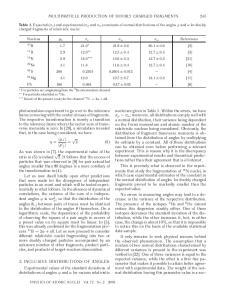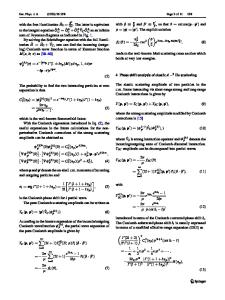Fragmentation of 7 Li relativistic nuclei on a proton into the 3 H + 4 He channel
- PDF / 593,624 Bytes
- 6 Pages / 612 x 792 pts (letter) Page_size
- 97 Downloads / 328 Views
EMENTARY PARTICLES AND FIELDS Experiment
Fragmentation of 7 Li Relativistic Nuclei on a Proton into the 3 H + 4 He Channel N. G. Peresadko, Yu. A. Alexandrov* , S. G. Gerasimov, V. A. Dronov, V. G. Larionova, A. V. Pisetskaya, E. I. Tamm, V. N. Fetisov, S. P. Kharlamov, and L. N. Shesterkina Lebedev Institute of Physics, Russian Academy of Sciences, Leninskii pr. 53, Moscow, 119991 Russia Received February 10, 2010; in final form, April 19, 2010
Abstract—In a track nuclear photoemulsion exposed to a beam of 7 Li nuclei accelerated to a momentum of 3 GeV/c per nucleon at the synchrophasotron of the Joint Institute for Nuclear Research (JINR, Dubna), 13 events in which 7 Li nuclei interacting with protons break up into 3 H and 4 He fragments were detected among 3730 inelastic-interaction events. For this fragmentation channel, the cross section was found to be 8 ± 2 mb. The average value of the fragment total transverse momentum was 214 ± 5 MeV/c. This value exceeds markedly the average value of the transverse-momentum transfer in the coherent dissociation of 7 Li nuclei on track-emulsion nuclei (166 ± 5 MeV/c). The recoil-proton transverse momentum was on average 98% of the total proton momentum. The longitudinal-momentum distribution of protons was characterized by a variance of 16 MeV/c and a mean value of 37 ± 2 MeV/c. DOI: 10.1134/S1063778810110177
INTRODUCTION Inelastic interactions of nucleons or nuclei with nuclei at high energies (corresponding to momenta of a few GeV/c units per nucleon) for the case where one reaction channel is singled out have been studied much less adequately than elastic scattering. The theory of inelastic reactions at these energies is based on various versions of the Coulomb mechanism of the excitation of nuclei [1] and on the Glauber– Sitenko diffraction theory of multiple collisions [2]. In practical applications, all of these approaches employ various approximations and therefore call for an experimental verification. In the overwhelming majority of studies devoted to considering inelastic collisions, the deuteron, which is the simplest nucleus, is used as a probing nucleus incident to the target. However, the presence of a neutron in the final state and the uncertainty in the states of the target nucleus after a collision event complicate experimental verification of the aforementioned theoretical approaches. Among inelastic interactions of 7 Li nuclei in a track nuclear emulsion that were accelerated to a momentum of 3 GeV/c per nucleon, events of the cluster fragmentation of 7 Li nuclei into the 3 H + 4 He channel without meson production and without apparent excitation of target nuclei, this being indicative of a coherent fragmentation of projectile *
E-mail: [email protected]
nuclei, were detected in [3, 4]. The vector sum of the transverse momenta of relativistic fragments that was measured experimentally in those events is the transverse-momentum transfer in the respective reaction, Q. The measured dependence of the differential cross section for the reaction in questi
Data Loading...











